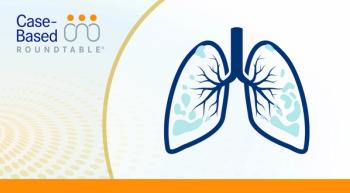
Peers & Perspectives in Oncology
- November I, 2023
- Volume 1
- Issue 8
- Pages: 66
Mileham Evaluates Survival Outcomes of Immunotherapy in Extensive-Stage SCLC

During a Community Case Forum event in partnership with the South Carolina Oncology Society, Kathryn Mileham, MD, discussed the significance of the IMpower133 and CASPIAN trials for patients with extensive-stage small cell lung cancer.
Targeted Oncology: What role did the IMpower133 trial (NCT02763579) establish for immunotherapy (IO) in patients with ES-SCLC?
MILEHAM: IMpower133 is the atezolizumab [Tecentriq] trial. [Patients were randomly assigned on a 1:1 basis to receive] carboplatin at [area under curve] 5 mg/mL/min, etoposide at 100 mg/m2, [plus placebo] vs [the same chemotherapy with] the addition of atezolizumab.
Atezolizumab was given on a 21-day cycle, and adjustments could be made in the maintenance setting. This trial did allow for patients with treated asymptomatic brain metastases. There were coprimary end points of investigator-assessed progression-free survival [PFS] and overall survival [OS]. I always think about the statistical design that has to go into that.
The PFS is still short among both of these groups [4.3 months with placebo vs 5.2 months with atezolizumab]…it’s not enough for me to see a 1-month difference in PFS.1 The thing that stands out to me is… you started out with 200 patients who were progression free, and at 5 months you’re already down to 50% in both arms. To me, those are the things that stand out and where we still need to [make an] impact. The stratified HR is still 0.77 [favoring atezolizumab; 95% CI, 0.62-0.96] and the P value is .02.
When these data came out…I was a slow adopter of IO. To me, it still wasn’t the impact we were getting in non–small cell lung cancer [NSCLC]. I wasn’t sure what I was adding to it outside of expense. I didn’t feel like I was adding toxicity…but you do get that 2-month improvement in median OS with statistical significance [at a median follow-up of 22.9 months, 10.3 months for vs 12.3 months for atezolizumab; HR, 0.76; 95% CI, 0.60-0.95; P = .0154].2 But I wasn’t overwhelmed with this. It was not routine in my practice when these data came out.
Is there a significant percentage of oncologists who still don’t give IO in patients with ES-SCLC?
Yes, there are. For me, the transition was when the durvalumab [Imfinzi] data came out, not necessarily because it was a better drug but because it was validation that there’s a signal here and there was another study that demonstrated that. For me, it was the longer follow-up with durvalumab that came out. There were some patients to whom I was giving IO, but it wasn’t a 100% transition.
Atezolizumab [received] FDA approval in March 2019.3 When the durvalumab data came out, I [thought] there was something going on [because] the data were very similar—from improvement in median OS, HRs, and it had the longer follow-up data [where] we see that if you’re a responder, there seems to be a durability.4,5 If you respond to IO, it tends to give you durability, but you have to be in that responder group. That is where our biggest challenge still lies. But, yes, there are a lot of oncologists who still have not adopted this as a part of their standard of care.
What subgroups of patients benefited most with atezolizumab?
When we look at the subgroup analysis—at age and patients who responded—there was not a lot [of benefit] with brain metastases.2 This is an important part. We haven’t found anything predictive with tumor mutational burden or PD-L1 expression in the data. There are a lot of studies going on, looking at different subtypes of SCLC; the inflamed subtype keeps coming up. We will be looking at how can we identify small cell [tumors] that are more sensitive to immunotherapy. There is more to come, but we know SCLC is a heterogeneic cancer. We just haven’t figured out how to tap into that.
The median duration of response [DOR] makes me [disappointed], that we cannot do better than [4.2 months].1 But for those who are responding, it’s durable. That is what you’re going to get out of IO that you’re not going to get out of a cytotoxic [therapy]. The ongoing response at 2 years was 9% [with atezolizumab] vs 2% [with chemotherapy alone].6 I’m going to give IO to every patient who is eligible [because of] those patients who get that durable response.
Why was there a greater improvement in OS for older patients vs younger patients?2
There are some interesting data…I don’t know that there is [a significant] benefit, but there are some other data that show that older patients tolerate IO better than younger patients. I don’t know [whether] tolerability is influencing it, or getting more of it, or whether it [is due to] dose intensity.
Are there any economic analyses on the cost vs benefit of IO in SCLC?
The cost analyses are important and hard to do. We’ve tried to do this at Atrium Health Levine Cancer Institute, and you start doing it based on patients’ insurance—what they’re paying [vs] what’s getting covered. We’ve also done cost analyses based on rurality [using] zip codes and different financial components, [but] it’s hard to get the data. It’s hard to figure out what data are going to reflect cost. But I think that’s got to come out…in real-world settings, and it’s not going to be driven by the industry itself.
What stood out about the design of the phase 3 CASPIAN trial (NCT03043872) of the addition of durvalumab to chemotherapy in patients with ES-SCLC?
There were [slightly] different eligibility [requirements] in CASPIAN; you could have asymptomatic and stable or treated and stable brain metastases. This was a 3-arm study with a 1:1:1 randomization. One arm received durvalumab plus tremelimumab [Imjudo] plus etoposide/platinum. The intent-to-treat population was the platinum/etoposide vs platinum/etoposide plus durvalumab. There was a stratification between [patients who received] cisplatin and carboplatin. There were a lot of investigator options, [including the choice of cisplatin or carboplatin and 2 additional cycles of etoposide.
Durvalumab was given every 3 weeks for 4 cycles, then] could be given every 4 weeks in the maintenance setting. The primary end point was OS. What’s important about this study is the platinum/etoposide arm that was 4 cycles, [but] if you were not getting immunotherapy as an addition to the regimen, then you could push up to 6 cycles and give PCI [prophylactic cranial irradiation].
They wanted to maximize the opportunity for the patients in that standard arm. In the IO-based arms, PCI was not offered because at that point, there were not safety data for bringing the PCI into that space. Those patients would have not received PCI, but these patients have the option to, and it could go up to 6 cycles. This was also an international trial in more than 20 countries at more than 200 sites.
What were the most important outcomes of the CASPIAN trial?
What was important was the publication of 3-year OS data for SCLC.5 What’s impressive is that you can even show 3-year survival in SCLC, that there are still patients who are alive at 3 years with an extensive-stage disease. Median OS was almost exactly the same as what you were getting with atezolizumab with a 2-month improvement in median OS [10.5 months with platinum/etoposide vs 12.9 months with added durvalumab].
We see this even in NSCLC; our survival curves stay together until approximately 6 months, then you start to see that separation. In NSCLC, sometimes it’s at 3 months, and then you see that separation. This is where that IO is beating out the cytotoxic therapy and you’re getting that OS benefit. If you’re on the curve, it becomes a horizontal line with 3 years, still, with a 12% difference in OS [17.6% with durvalumab vs 5.8% without durvalumab].
It’s pretty impressive that…almost 18% of the patients [are] alive at 3 years [Figure5]. That’s a game changer. There’s no question that even if you still have [most] patients falling off early, the opportunity to get on that curve is very important.
Should patients continue maintenance IO indefinitely or stop at 2 years?
No, maintenance continued in the CASPIAN trial. Are there real-world data that show ongoing treatment vs 2 years of IO in the SCLC setting? It would be interesting for these companies to look at…the median number of cycles or look at that range of cycles that these patients received, and then look at some data cutoffs. I don’t know how small those subsets are, but it would be interesting to at least dive into that. The subset analyses are always helpful [to see] the differences. We looked at this in the PACIFIC trial [NCT02125461], where we looked at cisplatin vs weekly carboplatin/paclitaxel and consolidation vs no consolidation.
Here, we have cisplatin vs carboplatin. There wasn’t one that was detrimental. You didn’t lose anything by using carboplatin in the extensive stage. Here, it’s not the same on the age [as IMpower133]. The OS between age groups are similar; we didn’t see that the older patients stood out here. From the brain metastasis perspective, brain metastases are still challenging and we’re probably not adding anything with the addition of IO in that response. With a longer look at the PFS, the median PFS was still 5 months [5.1 months with durvalumab vs 5.1 without durvalumab], which is pretty similar to what was seen in IMpower133.7
[However], for those who are responding—similar to the OS data— the benefit is clearly going to be in the IO arm. The response rates were not very different, but the DOR is still significantly better with the addition of durvalumab.8
REFERENCES
1. Horn L, Mansfield AS, Szczęsna A, et al. First-line atezolizumab plus chemotherapy in extensive-stage small-cell lung cancer. N Engl J Med. 2018;379(23):2220-2229. doi:10.1056/NEJMoa1809064
2. Liu SV, Reck M, Mansfield AS, et al. Updated overall survival and PD-L1 subgroup analysis of patients with extensive-stage small-cell lung cancer treated with atezolizumab, carboplatin, and etoposide (IMpower133). J Clin Oncol. 2021;39(6):619-630. doi:10.1200/JCO.20.01055
3. FDA approves atezolizumab for extensive-stage small cell lung cancer. FDA. March 18, 2019. Updated March 19, 2019. Accessed October 9, 2023.
4. Paz-Ares L, Dvorkin M, Chen Y, et al. Durvalumab plus platinum-etoposide versus platinum-etoposide in first-line treatment of extensive-stage small-cell lung cancer (CASPIAN): a randomised, controlled, open-label, phase 3 trial. Lancet. 2019;394(10212):1929-1939. doi:10.1016/S0140-6736(19)32222-6
5. Paz-Ares L, Chen Y, Reinmuth N, et al. Durvalumab, with or without tremelimumab, plus platinum-etoposide in first-line treatment of extensive-stage small-cell lung cancer: 3-year overall survival update from CASPIAN. ESMO Open. 2022;7(2):100408. doi:10.1016/j.esmoop.2022.100408
6. Reck M, Liu SV, Mansfield AS, et al. IMpower133: updated overall survival (OS) analysis of first-line (1L) atezolizumab (atezo) + carboplatin + etoposide in extensive-stage SCLC (ES-SCLC). Ann Oncol. 2019;30(suppl 5):v710-v717. doi:10.1093/annonc/mdz264
7. Goldman JW, Dvorkin M, Chen Y, et al. Durvalumab, with or without tremelimumab, plus platinum-etoposide versus platinum-etoposide alone in first-line treatment of extensive-stage small-cell lung cancer (CASPIAN): updated results from a randomised, controlled, open-label, phase 3 trial. Lancet Oncol. 2021;22(1):51-65. doi:10.1016/S1470-2045(20)30539-8
8. Paz-Ares LG, Dvorkin M, Chen Y, et al. Durvalumab ± tremelimumab + platinum-etoposide in first-line extensive-stage SCLC (ES-SCLC): updated results from the phase III CASPIAN study. J Clin Oncol. 2020;38(suppl 15):9002. doi:10.1200/JCO.2020.38.15_suppl.9002
Articles in this issue
about 2 years ago
Gradishar Discusses Role of Elacestrant in ER+/HER2– Breast Cancerabout 2 years ago
Therapy Progression in TNBC Leads to Important Second-Line Decision








































